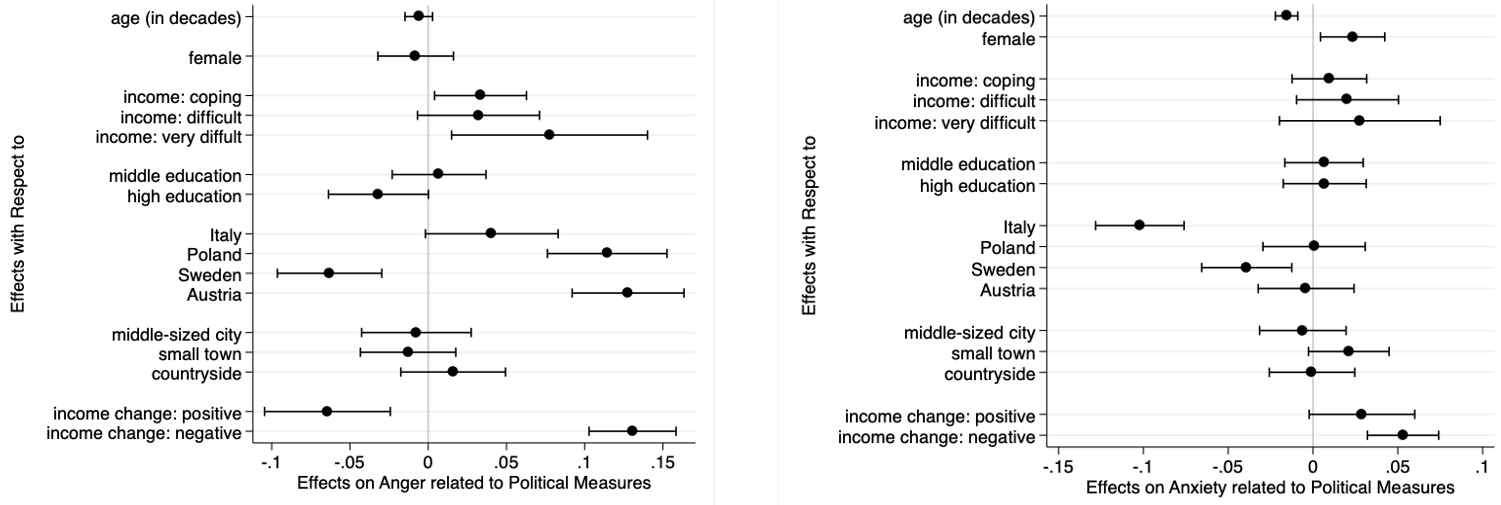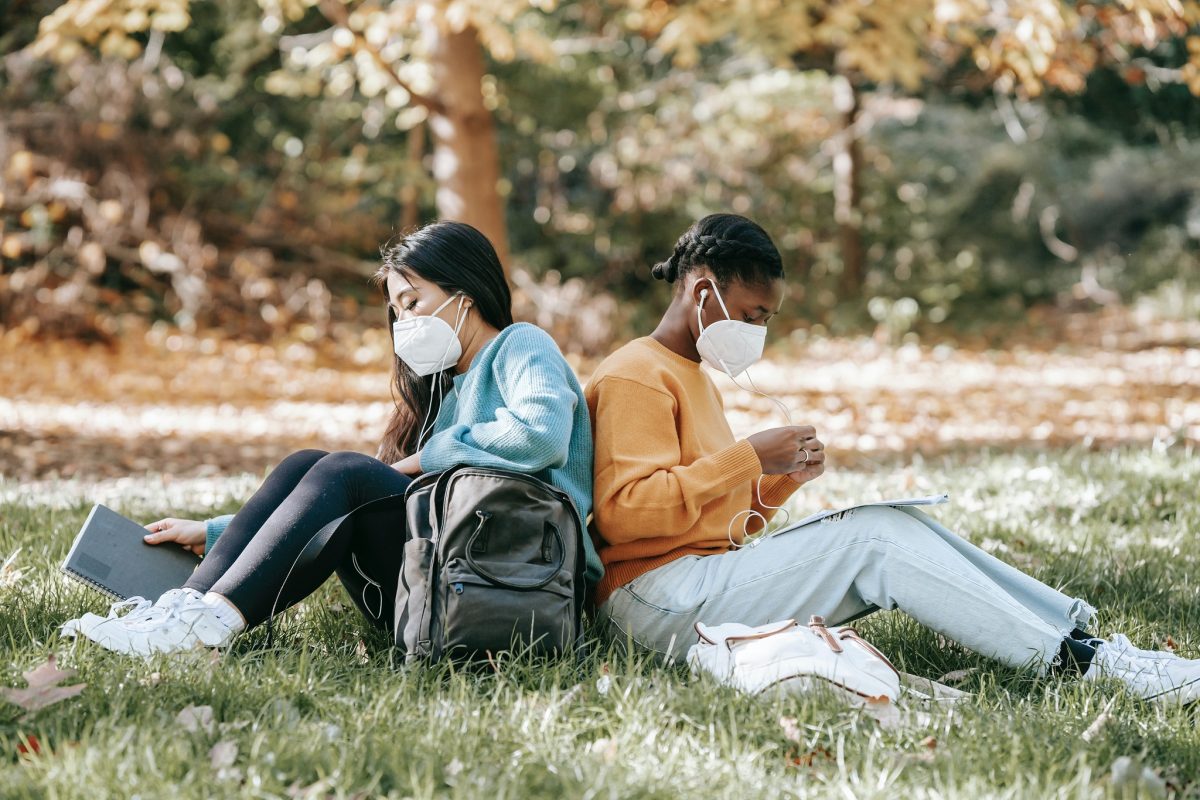By Theresa Uhr
Summary: The COVID-19 pandemic has turned our lives as we know them upside down. Measures to contain the virus affect our lives at every societal, economic, and personal level. This master’s thesis shows that emotional responses to the ongoing crisis are associated with socio-demographic characteristics as well as country-specific factors.
The consequences of the current pandemic are evident at every conceivable level in our society. However, people are affected differently depending on their life situations, socio-economic status, and socio-demographic characteristics. Age or pre-existing health conditions may pose a greater risk to some people than to others (cf. Linden, 2020). Further, certain lines of work are highly affected by economic consequences and/or the increased risk of infection. But measures to contain the virus also show their consequences on a mental health and an emotional level. Social distancing might bring loneliness and political measures can lead to anger and rage. Job losses and school closures can bring fears for the future and insecurities. In addition, the virus in many people evokes a sense of fear for their physical health and sadness about friends and family who are infected or lost their lives to the virus.
The current state of research indicates that predominantly negative emotions, such as anxiety, fear, sadness or anger, are prominent in the pandemic (see for example Barari et al., 2020; van der Vegt and Kleinberg, 2020; Li et al., 2020; Lwin et al., 2020; Li et al., 2021). Moreover, factors such as socio-demographics have significant impacts on emotional experiences during the pandemic (see for example Moghanibashi-Mansourieh, 2020; Rossi et al.; 2020; Jacques-Aviño et al., 2020; Orgilès et al., 2020; Pieh, Budimir and Probst, 2020). Next to differences related to socio-demographic characteristics, emotions seem to vary in relation to the domains to which they relate. Studies show that anger and fear, for example, are related to political debates and socioeconomic impacts (Stella, Restocchi and De Deyne, 2020), while sadness is experienced in view of the loss of friends and family and joy with regard to good health (Lwin et al., 2020).
In my master’s thesis in the program Sociology – European Societies at FU Berlin I aimed to contribute to emotion research related to COVID-19 by looking at emotions in different social and political domains. Therefore, I analyzed specific items of a cross-national survey conducted by the project “Social Cohesion and Civil Society”, funded by the Berlin University Alliance (https://solciv.blog). The survey was conducted using an online access panel in Germany, Italy, Poland, Sweden, and Austria between October 6 and November 4, 2020. The main focus of my thesis was the survey question of whether or not respondents feel certain emotions related to certain social or political domains during the pandemic. In more detail, anger and anxiety were examined, each in relation to economic development, other people’s behavior, and political measures.
In a regression analysis, I examined how anger and anxiety are experienced in relation to these three domains while accounting for several socio-demographic and country-level factors (as an example see Figure 1). The analyses show that differences in socio-demographic characteristics and countries are associated with the experience of emotions in different domains, although this relationship is complex and not always consistent. In some cases, the effects point in opposite directions or remain insignificant, depending on the specific emotion or the domain. The most ambivalent factors appear to be respondents’ socio-economic background (measured by income and education) and the countries of residence. This suggests that the social structures of emotional experience during global crises such as the COVID-19 pandemic have multifaceted correlates.
However, the analyses also show a number of consistent results, of which I will focus on age, gender, and income in the following. It appears that both female and younger respondents experience anger and anxiety in all three domains significantly more often than male and older respondents, although the effects are more pronounced for anxiety compared to anger.
Figure 1 Anger and Anxiety related to Polical Measures: Average Marginal Effects with 95% Confidence Intervals
 Source: own calculations
Source: own calculations
The figures show the average marginal effects of age, gender (male), income (living comfortably), education (low), belonging to a specific country (Germany), living area (big city) and income change (no change) on anger and anxiety during COVID-19 related to political measures. (All categorial variables were intepreted in relation to their reference category.)
One explanation for this finding is that women as well as younger respondents are more often in precarious occupations, which increases their risk of job loss. In addition, women more frequently work in occupations with a higher risk of infection (e.g., care work). And the closure of schools and daycare centers led to conflicts between childcare and paid work, which especially applies to women (Holst, Niehoff and Fessler, 2020, p. 40). Additionally, the housing situation can play a major role. Women are significantly more likely to be affected by domestic violence than men (García-Moreno et al., 2005). COVID-19 has significantly exacerbated the precarious situation of people affected by domestic violence by closing public assistance facilities during lockdown (see for example Bradbury‐Jones and Isham, 2020; Goh, Lu and Jou, 2020).
Regarding younger respondents, anxiety related to political measures (see Figure 1) can be an expression of the fact that many younger people have expressed feeling neglected by politics during the crisis. Younger people are hardly affected by health risks, but they are the most affected at an economic and psychological level (cf. Belot et al., 2021). The fact that younger respondents are more likely to feel anxiety towards political measures may reflect this fact. Schools, universities, pubs, clubs, and public places were closed to protect vulnerable groups during the pandemic. Protection of the elderly, one might say, was carried out on the backs of the younger generations.
The results also show that younger respondents are more inclined to feel anger in relation to economic development and more inclined to feel anxiety in relation to other people’s behavior and political measures. This is consistent with findings from recent studies that have looked at emotions and mental health during or after lockdown situations. The results show that especially younger people exhibit the highest levels of anxiety and depressions (see for example Jacques-Aviñó et al., 2020; Moghanibashi-Mansourieh, 2020; Orgilés et al., 2020; Pieh, Budimir and Probst, 2020).
One explanation for this could be that measures such as lockdowns and social distancing represent a greater change in the lives of younger compared to older individuals. Lockdown measures have meant a more radical change in younger citizens day-to-day activities compared to older citizens. Especially when younger individuals live with their parents, public places are often the only retreats available to them. Interfamily conflicts and violence in the family could be an influencing factor here.
Another consistent finding is the effect of income changes during the pandemic. It is the only variable that consistently shows the same effect: negative income changes are always associated with a higher frequency of experiencing anger or anxiety in all social domains. This suggests that changes in income due to COVID-19 are related to anger and anxiety experiences in all domains under investigation. Interestingly, changes in income have a much greater impact than income itself. This might be explained by the fact that income serves as a broader indicator for respondents’ socio-economic background, whereas income changes due to COVID-19 are a more direct measure of how hard one was hit by the pandemic.
The results highlight that income changes should also be included in future studies on emotions during the pandemic while accounting for individuals’ overall socio-demographic backgrounds. Moreover, in subsequent analyses, most notable associations between socio-demographic characteristics and emotions should be looked at concurrently, for example, age and gender or gender and income changes. This can provide more detailed insights into the complex relationships of inequality and the emotional repercussions of the pandemic.
Literature
Barari, S. et al. (2020) Evaluating COVID-19 Public Health Messaging in Italy: Self-Reported Compliance and Growing Mental Health Concerns. preprint. Public and Global Health.
Belot, M. et al. (2021) ‘Unequal consequences of Covid 19: representative evidence from six countries’, Review of Economics of the Household, 19(3), pp. 769–783.
Bradbury‐Jones, C. and Isham, L. (2020) ‘The pandemic paradox: The consequences of COVID‐19 on domestic violence’, Journal of Clinical Nursing, 29(13–14), pp. 2047–2049.
Goh, K.K., Lu, M. and Jou, S. (2020) ‘Impact of COVID-19 pandemic: Social distancing and the vulnerability to domestic violence’, Psychiatry and Clinical Neurosciences, 74(11), pp. 612–613.
Holst, H., Niehoff, S. and Fessler, A. (2020) ‘Covid-19 und die Arbeitswelt. Berufliche Ungleichheiten im Arbeitserleben in der Pandemie’.
Jacques-Aviñó, C. et al. (2020) ‘Gender-based approach on the social impact and mental health in Spain during COVID-19 lockdown: a cross-sectional study’, BMJ Open, 10(11).
Li, S. et al. (2020) ‘The Impact of COVID-19 Epidemic Declaration on Psychological Consequences: A Study on Active Weibo Users’, International Journal of Environmental Research and Public Health, 17(6), p. 2032.
Li, Ying et al. (2021) ‘Changing Emotions in the COVID-19 Pandemic: A Four-Wave Longitudinal Study in the United States and China’, Medical Letter on the CDC & FDA, p. 85.
Linden, M. (2020) ‘Auswirkungen der Pandemie: Gesundheitskrise, Ökonomie und Ungleichheit’, Geographica Helvetica, 75(3), pp. 307–313.
Lwin, M.O. et al. (2020) ‘Global Sentiments Surrounding the COVID-19 Pandemic on Twitter: Analysis of Twitter Trends’, JMIR Public Health and Surveillance, 6(2).
Moghanibashi-Mansourieh, A. (2020) ‘Assessing the anxiety level of Iranian general population during COVID-19 outbreak’, Asian Journal of Psychiatry, 51.
Orgilés, M. et al. (2020) Immediate psychological effects of the COVID-19 quarantine in youth from Italy and Spain. preprint.
Renström, E.A. and Bäck, H. (2021) ‘Emotions during the Covid‐19 pandemic: Fear, anxiety, and anger as mediators between threats and policy support and political actions’, Journal of Applied Social Psychology, 51(8), pp. 861–877.
Rossi, R. et al. (2020) ‘COVID-19 Pandemic and Lockdown Measures Impact on Mental Health Among the General Population in Italy’, Frontiers in Psychiatry, 11, p. 790.
Smith, T. W., Rasinski, K. A. and Toce, M. (2002) ‘America Rebounds: A National Study of Public Response to the September 11th Terrorist Attacks. Preliminary Findings’. National Organization for Research at the University of Chicago (NORC). Available at: https://www.norc.org/PDFs/publications/SmithT_America_Rebounds_2001.pdf
Steinberg, K.S. and Rooney, P.M. (2005) ‘America Gives: A Survey of Americans’ Generosity After September 11’, Nonprofit and Voluntary Sector Quarterly, 34(1), pp. 110–135.
Stella, M., Restocchi, V. and De Deyne, S. (2020) ‘#lockdown: Network-Enhanced Emotional Profiling in the Time of COVID-19’, Big Data and Cognitive Computing, 4(2), p. 14.
van der Vegt, Isabelle and Kleinberg, B. (2020) ‘Women Worry About Family, Men About the Economy: Gender Differences in Emotional Responses to COVID-19’, in Aref, S. et al. (eds) Social Informatics. Cham: Springer International Publishing (Lecture Notes in Computer Science), pp. 397–409.
